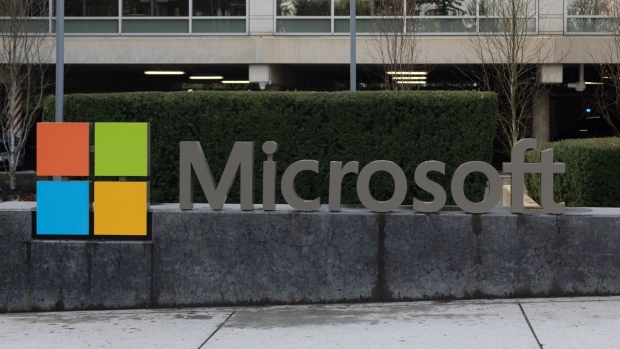Microsoft Corp. it reported tepid fourth-quarter sales growth, hampered by slowing demand for cloud-computing services as the software maker expects a rise in revenue from new products powered by artificial intelligence.
Profit in the period ended June 30 was US $ 2.69 per share and sales rose 8 per cent to US $ 56.2 billion, the software maker said in a statement on Tuesday. While the overall results topped analysts ‘ forecasts, revenue growth from Cloud services slowed to 27 percent, excluding currency fluctuations, from 31 percent in the previous quarter.
Chief Executive Satya Nadella has unveiled a series of new AI programs — based on models from partner OpenAI — for most of Microsoft’s major product lines, and demand is growing for web-based services that allow customers to use OpenAI Technologies. However, the company’s office productivity suite including AI is not yet widely available, and overall spending on Azure services and office applications is easing after several years of increased corporate investment. At the same time, shipments of personal computers fell for the sixth quarter in a row, eroding sales of mobile devices and Surface devices.
“Customers who had been gung ho in the cloud turned around and said, ‘We’d better optimize what we bought,'” said Mark Moerdler, an analyst at Sanford C. Bernstein & Co. “You will not see great winds from it — it will be rising.”
Shares fell about 1 percent after the report, after climbing to $ 350.98 at the close in New York. Shares rose 18 percent in the three months ending in June, outpacing the s&P 500 Index’s 8.3 percent rise in that period. Last week, Microsoft shares hit a record high, driven by optimism about new AI strategies and products.
Amy Hood, Microsoft’s chief financial officer, said Azure’s growth rate of the latest period was at the bottom of what she had predicted, noting that she was “very pleased with that number.”It’s typical for customers to try to get the most out of the cloud-based products they’ve already purchased,” Hood said in an interview, but she expects less of an impact on Microsoft’s results in the coming quarters.
For the fiscal fourth quarter, analysts on average had estimated US $ 2.56 per share in profits and US $ 55.5 billion in sales, according to a Bloomberg survey.
Annual sales growth moderated to 7% in 2023, the company said, after five consecutive years of growth above 10%. Microsoft laid off 10,000 workers in the March quarter, including in key businesses such as Azure and security software. The Redmond, Washington – based company made a smaller number of additional downloads in July, in areas like sales and support.
The company is increasing spending to expand data centers and buy chips needed to run complex AI systems. To make up for the hefty investments, Microsoft is opening up ways to generate money from those products; earlier this month, the company set a price of US $ 30 per month per user for its Office AI tools, called Microsoft 365 Copilot — on top of what most business customers already pay for the business productivity suite, which includes a-list, Excel, email and conference software.
Microsoft has invested $ 13 billion in startup OpenAI, a partnership that took the 48-year-old software maker to the forefront of a race to build new applications that allow customers to create new content from their existing data as well as information deleted from the web. Microsoft is revising the majority of its products — including Office, 8, Azure, and bing search — around OpenAI’S latest language model, GPT-4, and adding chatbot technology similar to the viral hit startup ChatGPT.
“I’m very encouraged by the pace of adoption of our AI tools,” Hood said.
Revenue at Microsoft’s Smart Cloud unit, made up of Azure software and servers, was $ 24 billion, slightly above analysts ‘ average forecast of $ 23.8 billion.
Microsoft’s sales of mobile operating system software pre-installed on computers fell 12 percent in the June quarter, a period when global PC shipments fell 13 percent, according to market research firm IDC. Although this industry decline marked the sixth consecutive quarterly contraction in the market, total unit sales were better than forecast, IDC said. Microsoft’s Hood said some school PC sales occurred in the June quarter, helping to boost results, but overall trends in the PC market are unchanged.
In the company’s most Personal computing division, the unit that includes software, Surface devices and Xbox businesses, sales fell to $ 13.9 billion, compared with the average estimate of $ 13.6 billion. In the Productivity segment, mainly office sales, revenue increased to $ 18.3 billion. This is slightly above the projected $ 18.1 billion.
Microsoft’s Xbox content and services revenue grew by 5 percent. The business has seen tepid growth for the past few quarters after a boom in play during the pandemic.
The software maker’s $ 69 billion deal to buy game publisher Activision Blizzard Inc. the company, which has been working its way through regulatory challenges, was originally scheduled to be completed by the end of June, but the companies last week extended their merger agreement until October. 18 to give Microsoft more time to work out the final hurdles.
In the past two weeks, momentum has shifted in favour of the deal — the US Federal Trade Commission lost an attempt to block it in court, and the UK’s competition and Markets Authority said it would take the unprecedented step of re-engaging in talks with companies to restructure the transaction.
“We’re going to focus on working through the remaining regulatory bodies and working toward shutting down — that’s where our energy is,” Hood said.
#Microsoft #posts #lukewarm #sales #growth #cloud #business #slowsBNN #Bloomberg
